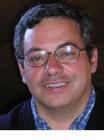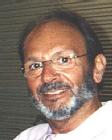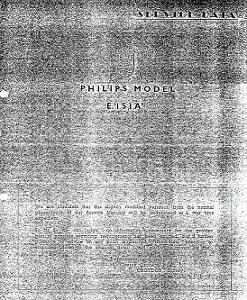The Philips E151A
The Philips E151A
To thank the Author because you find the post helpful or well done.
Not sure
Since you don't give the URL I can not really tell what he meant. I would interpret it that he indicates that we should not just copy text from other sources without permission and/or without naming the source.
If you have your (own) text in word or another editor then you can also put it into our WYSIWYG-Editor but you preferably use the "T"-pictogram - and will have plain text without formatting. This causes no problem at all. There are texts about handling our editor in the FAQ.
To thank the Author because you find the post helpful or well done.
Copying of text from other sources

I would like to explain what the new member from Argentina, Sr Carlos Landi, was inserting into his post to the E151A thread, some information which helps to understand the "forensics" of identifying unknown models by the "sum of their individual parts".
Carlos had sent me a direct email to ask for my assistance to determine the most likely makers of 2 radios that he had; and since he is relatively new to the radio collecting hobby, I offered my assistance. Incidentally, he has a nice collection considering the short time he has been involved with the hobby.
He sent to me the 5 photographs of a "presumed early Stewart Warner lowboy" and 5 photographs of the model that he believed may have been an early Westinghouse.
I carefully reviewed every photograph he sent to me; and then I described in detail each of the photographs. He had my permission to use the information in any manner he chose.
He simply posted the exact verbatim output from the translator. . . .even I overlooked several errors.
I believe that Carlos may have posted the items in the E151A thread because he was quite pleased that I would take the slight amount of time to help him accurately determine what radios he really had.
Respectfully,
Robert
Please note that we have many new members who are having to learn the details that most of us have learned after MANY instances of TRIAL and ERROR.
To thank the Author because you find the post helpful or well done.

Dear Robert,
it would have not been necessary to repost your email. The only thing we can learn from that, is that the accentuated letters are readible and the text does not break boundaries in it's original form.
Incidentally, this is exactly what I was referring to. Again, look for yourself in the two threads in question.
Nowhere did I say that there were errors in the text. I think it good to help new members, this was also not criticised by me. You will certainly agree that (due to formatting and character set problems) an almost illegible lenght of text (about some completely different radios) does in no way add to the identification of the E151A.
In any case, Lars, I was indeed referring to the formatting of the text, which most likely came from a copy action from within an email client, that induced a change in codepage (hence the loss of accentuation) and line breaks.
Kind regards,
Mark
Edit: for your reference, this thread is a continuation of the previous thread that can be found here. I have removed my and Carlos' posts from that thread and encouraged him to re-post. MH
To thank the Author because you find the post helpful or well done.
RADIO PHILIPS E151A

Dear Radio Friends,
Thank You for your replies.
Let us talk about my radio E151A ? (I hope you remember yet the subject that we were talking about.) :-)
Thank You Mario Huizinga for your so helpful and profitable explanation and for the photo of E151A which I present in my last post.
(I didn’t buy that radio. I sent that photo because my camera was out of order and only now I have a new camera).
Here it is, my E151A:
I have now extreme difficulties to repair it without a schematic. Have You one or do You know where to find it?
May I presume, from all that was written before, that is this an English radio? That's because I’d like to create this new model in Rmorg.
Best Regards
Jose Duarte Costa
- Imagem 010 (51 KB)
- Imagem 020 (18 KB)
- Imagem 009 (180 KB)
To thank the Author because you find the post helpful or well done.

According to the tube lineup from the E151A depicted in Mario Huizinga's site, the tubes when placed into the RMorg search lineup (please omit the DW4 rectifier or substitute the AZ31) and activated - you find that the Pye model 36H seems to be the most nearly exact model.
Other than the 4volt rectifiers (DW4 or AZ31), the tubes of the E151A and the Pye 36H are identical.
There is a schematic so it should give fairly accurate details.
Respectfully,
Robert
To thank the Author because you find the post helpful or well done.
English for sure

Dear José Duarte,
Our friend and Rmorg's friend António Manuel Rodrigues dos Santos,( who I already presented here in this forum, he is, as far as I know, the greatest Portuguese radio's collector), he is also a frequent reader of our Rmorg's foruns),

He kindly sent us 9 Service Data pages of E.151A. He has one E.151A too.
Thank you, once more, Mr. António Manuel Rodrigues dos Santos.
These data pages are slightly different from the normal Philips presentation.(see bellow)
Reading the front page (though it is very dark) is easy to understand that this model is an English model,from:
Service Department,
74-94, Cherry Orchard Road,
Croydon, Surrey
Front page:

Detail of front page legend:

The schematics included in this data sheets are not very clear and need restoring. I'm doing now that job.
Now I think you have enough data to create this model in Rmorg. Then after I'll send the schematics to Rmorg.
Best Regards
Mário Coelho
PS: Picture ajusted to 500 pixels. I hope it is readable yet :-).
GR: Picture adjusted to 560 ... for shure. Please read this.
- GB_Philipsr_CE151A_Fontdata001 (56 KB)
To thank the Author because you find the post helpful or well done.
...but this radio is also a Bush!

Dear fellow collectors,
I stumbled across this radio as I was about to e-mail Jose on another matter - and it has been a revelation! The reason is that I found myself looking at this Philips radio... but it is shouting at me "I'm a Bush!"
The Bush radio concerned is the model EBS 74, which dates from around 1942 and was, as far as I am aware, their first model made for export although examples were sold in the UK at the time - although I do not have an example of the set I have an instruction book and accompanying guarantee which gives a date of sale as February 1942 and it was sold in Bury, Lancashire. It too has the same valve arrangement and the same tuning scale arrangement. I also have a copy of the service manual for the EBS 74.
I then downloaded the schematics from Radiomuseum, and the first thing I noticed was that the schematic diagram is very obviously a product of the drawing office at Chiswick, where Bush were based. Meanwhile, the rest of the diagrams look like they came from the Philips drawing office - the point-to-point wiring diagrams and layouts being so typical of Philips. So I then located my service manual for the EBS 74 and noted that they are identical. Only the front cover is different! This also goes a long way to explaining why the parts list has a lot of items beginning MK.... which is typically Philips, as well as the usual P.... and CP.... items which are typically Bush. It may also explain why the service manual is not typically Philips in appearance either.
The cabinet is virtually identical in presentation to the 1940 Bush model PB 73 (with a smaller scale aperture), and the chassis is seemingly identical right down to the slide switch at the back. I will propose the model PB 73 (as it seems to be absent at the moment) to illustrate the point with photographic evidence but for the moment a picture from the 1940 Bush catalogue may be seen here.
Jose, could you confirm that your Philips set covers six bandspread short wave ranges as well as the Medium and "Intermediate" (48-150m) bands?
The other set illustrated in the model listing (the one with the curved top edge) is definitely a Bush, the Bush logo is very clear on the dial. This is a model EBS 84, which dates from 1946 and uses an identical valve line-up. I have the service manual for the DC/AC version of this set, the DAC 84 which confirms the set from its appearance.
This of course now raises a very interesting question: what prompted this collaboration between Bush and Philips?
To thank the Author because you find the post helpful or well done.
